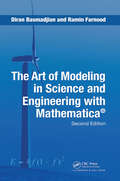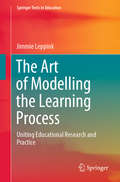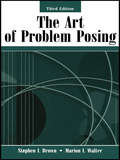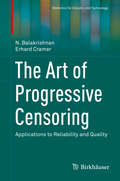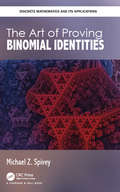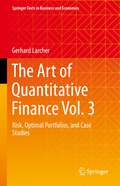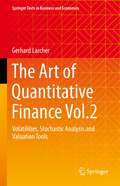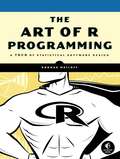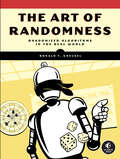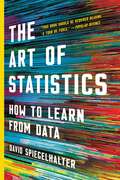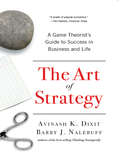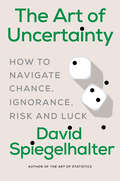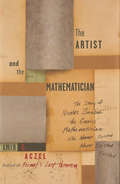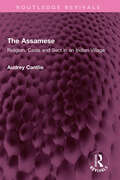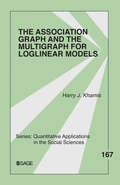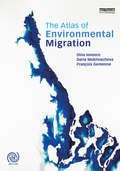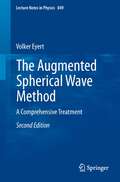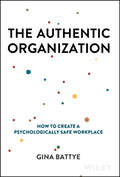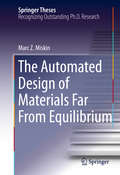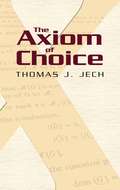- Table View
- List View
The Art of Modeling in Science and Engineering with Mathematica
by Diran Basmadjian Ramin FarnoodThoroughly revised and updated, The Art of Modeling in Science and Engineering with Mathematica, Second Edition explores the mathematical tools and procedures used in modeling based on the laws of conservation of mass, energy, momentum, and electrical charge. The authors have culled and consolidated the best from the first edition and
The Art of Modelling Computational Systems: Essays Dedicated to Catuscia Palamidessi on the Occasion of Her 60th Birthday (Lecture Notes in Computer Science #11760)
by Mário S. Alvim Kostas Chatzikokolakis Carlos Olarte Frank ValenciaThis Festschrift was published in honor of Catuscia Palamidessi on the occasion of her 60th birthday.It features 6 laudations, which are available in the front matter of the volume, and 25 papers by close collaborators and friends. The papers are organized in topical sections named: concurrency; logic and constraint programming; security and privacy; and models and puzzles.These contributions are a tribute to Catuscia Palamidessi’s intellectual depth, vision, passion for science, and tenacity in solving technical problems. They also reflect the breadth and impact of her work. Her scientific interests include, in chronological order, principles of programming languages, concurrency theory, security, and privacy.
The Art of Modelling the Learning Process: Uniting Educational Research and Practice (Springer Texts in Education)
by Jimmie LeppinkBy uniting key concepts and methods from education, psychology, statistics, econometrics, medicine, language, and forensic science, this textbook provides an interdisciplinary methodological approach to study human learning processes longitudinally. This longitudinal approach can help to acquire a better understanding of learning processes, can inform both future learning and the revision of educational content and formats, and may help to foster self-regulated learning skills. The initial section of this textbook focuses on different types of research questions as well as practice-driven questions that may refer to groups or to individual learners. This is followed by a discussion of different types of outcome variables in educational research and practice, such as pass/fail and other dichotomies, multi-category nominal choices, ordered performance categories, and different types of quantifiable (i.e., interval or ratio level of measurement) variables. For each of these types of outcome variables, single-measurement and repeated-measurements scenarios are offered with clear examples. The book then introduces cross-sectional and longitudinal interdependence of learning-related variables through emerging network-analytic methods and in the final part the learned concepts are applied to different types of studies involving time series. The book concludes with some general guidelines to give direction to future (united) educational research and practice. This textbook is a must-have for all applied researchers, teachers and practitioners interested in (the teaching of) human learning, instructional design, assessment, life-long learning or applications of concepts and methods commonly encountered in fields such as econometrics, psychology, and sociology to educational research and practice.
The Art of More: How Mathematics Created Civilization
by Michael BrooksAn illuminating, millennia-spanning history of the impact mathematics has had on the world, and the fascinating people who have mastered its inherent power, from Babylonian tax officials to the Apollo astronauts to the eccentric professor who invented the infrastructure of the online worldCounting is not innate to our nature, and without education humans can rarely count past three—beyond that, it&’s just &“more.&” But once harnessed by our ancestors, the power of numbers allowed humanity to flourish in ways that continue to lead to discoveries and enrich our lives today. Ancient tax collectors used basic numeracy to fuel the growth of early civilization, navigators used clever geometrical tricks to engage in trade and connect people across vast distances, astronomers used logarithms to unlock the secrets of the heavens, and their descendants put them to use to land us on the moon. In every case, mathematics has proved to be a greatly underappreciated engine of human progress. In this captivating, sweeping history, Michael Brooks acts as our guide through the ages. He makes the case that mathematics was one of the foundational innovations that catapulted humanity from a nomadic existence to civilization, and that it has since then been instrumental in every great leap of humankind. Here are ancient Egyptian priests, Babylonian bureaucrats, medieval architects, dueling Swiss brothers, and renaissance painters. Their stories clearly demonstrate that the invention of mathematics was every bit as important to the human species as was the discovery of fire. From first page to last, The Art of More brings mathematics back into the heart of what it means to be human.
The Art of Problem Posing
by Stephen I. Brown Marion I. WalterThe new edition of this classic book describes and provides a myriad of examples of the relationships between problem posing and problem solving, and explores the educational potential of integrating these two activities in classrooms at all levels. The Art of Problem Posing, Third Edition encourages readers to shift their thinking about problem posing (such as where problems come from, what to do with them, and the like) from the "other" to themselves and offers a broader conception of what can be done with problems. Special features include: an exploration of the logical relationship between problem posing and problem solving; sketches, drawings, and diagrams that illustrate the schemes proposed; and a special section on writing in mathematics.In the updated third edition, the authors specifically:*address the role of problem posing in the NCTM Standards;*elaborate on the concept of student as author and critic;*include discussion of computer applications to illustrate the potential of technology to enhance problem posing in the classroom;*expand the section on diversity/multiculturalism; and*broaden discussion of writing as a classroom enterprise.This book offers present and future teachers at the middle school, secondary school, and higher education levels ideas to enrich their teaching and suggestions for how to incorporate problem posing into a standard mathematics curriculum.
The Art of Progressive Censoring
by N. Balakrishnan Erhard CramerThis book offers a thorough and updated guide to the theory and methods of progressive censoring, an area that has experienced tremendous growth over the last decade. The theory has developed quite nicely in some special cases having practical applications to reliability and quality. The Art of Progressive Censoring is a valuable reference for graduate students, researchers, and practitioners in applied statistics, quality control, life testing, and reliability. With its accessible style and concrete examples, the work may also be used as a textbook in an advanced undergraduate or a beginning graduate course on censoring or progressive censoring, as well as a supplementary textbook for a course on ordered data.
The Art of Proving Binomial Identities (Discrete Mathematics and Its Applications)
by Michael Z. SpiveyThe Art of Proving Binomial Identities accomplishes two goals: (1) It provides a unified treatment of the binomial coefficients, and (2) Brings together much of the undergraduate mathematics curriculum via one theme (the binomial coefficients). The binomial coefficients arise in a variety of areas of mathematics: combinatorics, of course, but also basic algebra (binomial theorem), infinite series (Newton’s binomial series), differentiation (Leibniz’s generalized product rule), special functions (the beta and gamma functions), probability, statistics, number theory, finite difference calculus, algorithm analysis, and even statistical mechanics. The book is very suitable for advanced undergraduates or beginning graduate students and includes various exercises asking them to prove identities. Students will find that the text and notes at the end of the chapters encourages them to look at binomial coefficients from different angles. With this learning experience, students will be able to understand binomial coefficients in a new way. Features: Provides a unified treatment of many of the techniques for proving binomial coefficient identities. Ties together several of the courses in the undergraduate mathematics curriculum via a single theme. A textbook for a capstone or senior seminar course in mathematics. Contains several results by the author on proof techniques for binomial coefficients that are not well-known. Ideal for self-study, it contains a large number of exercises at the end of each chapter, with hints or solutions for every exercise at the end of the book.
The Art of Quantitative Finance Vol. 3: Risk, Optimal Portfolios, and Case Studies (Springer Texts in Business and Economics)
by Gerhard LarcherThe textbook discusses risk management in capital markets and presents various techniques of portfolio optimization. Special attention is given to risk measurement and credit risk management. Furthermore, the author discusses optimal investment problems and presents various examples. In the last section, the book includes numerous case studies based on the author’s own work as a fund manager, court-appointed expert and consultant in the field of quantitative finance. This book is the third volume of the quantitative finance trilogy by the author and builds on the theoretical groundwork introduced in the previous books. The volume presents real-life examples of the successful application of the introduced techniques and methods in financial services and capital markets.
The Art of Quantitative Finance Vol.2: Volatilities, Stochastic Analysis and Valuation Tools (Springer Texts in Business and Economics)
by Gerhard LarcherThis textbook provides the necessary techniques from financial mathematics and stochastic analysis for the valuation of more complex financial products and strategies. The author discusses how to make use of mathematical methods to analyse volatilities in capital markets. Furthermore, he illustrates how to apply and extend the Black-Scholes theory to several fields in finance. In the final section of the book, the author introduces the readers to the fundamentals of stochastic analysis and presents examples of applications. This book builds on the previous volume of the author’s trilogy on quantitative finance. The aim of the second volume is to present and discuss more complex and advanced techniques of modern financial mathematics in a way that is intuitive and easy to follow. As in the previous volume, the author provides financial mathematicians with insights into practical requirements when applying financial mathematical techniques in the real world.
The Art of R Programming: A Tour of Statistical Software Design
by Norman MatloffR is the world's most popular language for developing statistical software: Archaeologists use it to track the spread of ancient civilizations, drug companies use it to discover which medications are safe and effective, and actuaries use it to assess financial risks and keep economies running smoothly.The Art of R Programming takes you on a guided tour of software development with R, from basic types and data structures to advanced topics like closures, recursion, and anonymous functions. No statistical knowledge is required, and your programming skills can range from hobbyist to pro.Along the way, you'll learn about functional and object-oriented programming, running mathematical simulations, and rearranging complex data into simpler, more useful formats. You'll also learn to:–Create artful graphs to visualize complex data sets and functions–Write more efficient code using parallel R and vectorization–Interface R with C/C++ and Python for increased speed or functionality–Find new R packages for text analysis, image manipulation, and more–Squash annoying bugs with advanced debugging techniquesWhether you're designing aircraft, forecasting the weather, or you just need to tame your data, The Art of R Programming is your guide to harnessing the power of statistical computing.
The Art of Randomness: Randomized Algorithms in the Real World
by Ronald T. KneuselHarness the power of randomness (and Python code) to solve real-world problems in fun, hands-on experiments—from simulating evolution to encrypting messages to making machine-learning algorithms!The Art of Randomness is a hands-on guide to mastering the many ways you can use randomized algorithms to solve real programming and scientific problems. You&’ll learn how to use randomness to run simulations, hide information, design experiments, and even create art and music. All you need is some Python, basic high school math, and a roll of the dice.Author Ronald T. Kneusel focuses on helping you build your intuition so that you&’ll know when and how to use random processes to get things done. You&’ll develop a randomness engine (a Python class that supplies random values from your chosen source), then explore how to leverage randomness to:Simulate Darwinian evolution and optimize with swarm-based search algorithmsDesign scientific experiments to produce more meaningful results by making them truly randomImplement machine learning algorithms like neural networks and random forestsUse Markov Chain Monte Carlo methods to sample from complex distributionsHide information in audio files and images, generate art, and create musicReconstruct original signals and images from only randomly sampled dataScientific anecdotes and code examples throughout illustrate how randomness plays into areas like optimization, machine learning, and audio signals. End-of-chapter exercises encourage further exploration.Whether you&’re a programmer, scientist, engineer, mathematician, or artist, you&’ll find The Art of Randomness to be your ticket to discovering the hidden power of applied randomness and the ways it can transform your approach to solving problems, from the technical to the artistic.
The Art of Science
by Rossella Lupacchini Annarita AngeliniIn addition to linear perspective, complex numbers and probability were notable discoveries of the Renaissance. While the power of perspective, which transformed Renaissance art, was quickly recognized, the scientific establishment treated both complex numbers and probability with much suspicion. It was only in the twentieth century that quantum theory showed how probability might be molded from complex numbers and defined the notion of "complex probability amplitude". From a theoretical point of view, however, the space opened to painting by linear perspective and that opened to science by complex numbers share significant characteristics. The Art of Science explores this shared field with the purpose of extending Leonardo's vision of painting to issues of mathematics and encouraging the reader to see science as an art. The intention is to restore a visual dimension to mathematical sciences - an element dulled, if not obscured, by historians, philosophers, and scientists themselves.
The Art of Statistics: How to Learn from Data
by David SpiegelhalterThe definitive guide to statistical thinkingStatistics are everywhere, as integral to science as they are to business, and in the popular media hundreds of times a day. In this age of big data, a basic grasp of statistical literacy is more important than ever if we want to separate the fact from the fiction, the ostentatious embellishments from the raw evidence -- and even more so if we hope to participate in the future, rather than being simple bystanders.In The Art of Statistics, world-renowned statistician David Spiegelhalter shows readers how to derive knowledge from raw data by focusing on the concepts and connections behind the math. Drawing on real world examples to introduce complex issues, he shows us how statistics can help us determine the luckiest passenger on the Titanic, whether a notorious serial killer could have been caught earlier, and if screening for ovarian cancer is beneficial. The Art of Statistics not only shows us how mathematicians have used statistical science to solve these problems -- it teaches us how we too can think like statisticians. We learn how to clarify our questions, assumptions, and expectations when approaching a problem, and -- perhaps even more importantly -- we learn how to responsibly interpret the answers we receive.Combining the incomparable insight of an expert with the playful enthusiasm of an aficionado, The Art of Statistics is the definitive guide to stats that every modern person needs.
The Art of Strategy: A Game Theorist's Guide to Success in Business and Life
by Barry J. Nalebuff Avinash K. Dixit"I am hard pressed to think of another book that can match the combination of practical insights and reading enjoyment."--Steven Levitt Game theory means rigorous strategic thinking. It's the art of anticipating your opponent's next moves, knowing full well that your rival is trying to do the same thing to you. Though parts of game theory involve simple common sense, much is counterintuitive, and it can only be mastered by developing a new way of seeing the world. Using a diverse array of rich case studies--from pop culture, TV, movies, sports, politics, and history--the authors show how nearly every business and personal interaction has a game-theory component to it. Mastering game theory will make you more successful in business and life, and this lively book is the key to that mastery.
The Art of Uncertainty: How to Navigate Chance, Ignorance, Risk and Luck
by David SpiegelhalterNamed a Best Book of the Year by Forbes and The Economist From our "greatest living statistical communicator" (Tim Harford) comes an invaluable, data-driven guide for understanding—and learning to embrace—risk and uncertainty in our daily lives. How dangerous is our diet? How much of sports falls into the realm of luck? When authorities categorize a given event as “highly likely”—how likely is that, really? Whether we’re trying to decide if the benefits of a new medication are worth the chance of side effects or if artificial intelligence truly threatens humanity, our lives are riddled with uncertainties both everyday and existential—yet it can be difficult to know how to properly weigh all those unknowns. Luckily for us, renowned statistician David Spiegelhalter has spent his career dissecting data to resolve the apparently random and decode the many decisions we face with imperfect information. In The Art of Uncertainty, he shows how we can become better at dealing with what we don’t know to make smarter choices in a world so full of puzzling variables. In lucid, lively prose, Spiegelhalter guides us through the principles of probability, illustrating how they can help us think more analytically about everything from medical advice to sports to climate change forecasts. He demonstrates how taking a mathematical approach to phenomena we might otherwise attribute to fate or luck can help us sort hidden patterns from mere coincidences, better evaluate cause and effect, and predict what’s likely to happen in the future. Along the way, we learn how a misinterpretation of a probability contributed to the infamous Bay of Pigs fiasco, why a ship twice the size of the Titanic sank without a trace, and why we can be so confident that no two properly shuffled decks of cards have ever been in the same order. Sparkling with wit and fascinating real-world examples, this is an essential guide to navigating uncertainty while also retaining the humility to admit what we don’t, or simply cannot, know.
The Artist and the Mathematician
by Amir AczelNicolas Bourbaki, whose mathematical publications began to appear in the late 1930s and continued to be published through most of the twentieth century, was a direct product as well as a major force behind an important revolution that took place in the early decades of the twentieth century that completely changed Western culture. Pure mathematics, the area of Bourbaki's work, seems on the surface to be an abstract field of human study with no direct connection with the real world. In reality, however, it is closely intertwined with the general culture that surrounds it. Major developments in mathematics have often followed important trends in popular culture; developments in mathematics have acted as harbingers of change in the surrounding human culture. The seeds of change, the beginnings of the revolution that swept the Western world in the early decades of the twentieth century -- both in mathematics and in other areas -- were sown late in the previous century. This is the story both of Bourbaki and the world that created him in that time. It is the story of an elaborate intellectual joke -- because Bourbaki, one of the foremost mathematicians of his day -- never existed.
The Assamese: Religion, Caste and Sect in an Indian Village (Routledge Revivals)
by Audrey CantlieFirst published in 1984, The Assamese is an anthropological exploration of Assam. The many tribes living in the hill tracts of Assam early engaged the attention of anthropologists but no significant studies have been made of the people living in the Assam valley who call themselves Assamese, the distinctive features of whose culture are inseparably connected with their religious institutions. The purpose of this book is to give an account of the way of life which the Assamese people are seeking to preserve, and its chief claim to attention is that it is the very first field-study of the village foundations of social life in Assam, containing a plenitude of detailed information on local aggregates, caste divisions, modes of livelihood, devotional practices, marriage patterns, and much else. This book will be of interest to students of anthropology, ethnic studies, history and cultural studies.
The Association Graph and the Multigraph for Loglinear Models (Quantitative Applications in the Social Sciences)
by Harry J. KhamisThis practical guide teaches nonstatisticians how to analyze and interpret loglinear models using the multigraph The Association Graph and the Multigraph for Loglinear Models will help students, particularly those studying the analysis of categorical data, to develop the ability to evaluate and unravel even the most complex loglinear models without heavy calculations or statistical software. This supplemental text reviews loglinear models, explains the association graph, and introduces the multigraph to students who may have little prior experience of graphical techniques, but have some familiarity with categorical variable modeling. The author presents logical step-by-step techniques from the point of view of the practitioner, focusing on how the technique is applied to contingency table data and how the results are interpreted.
The Atiyah-Patodi-Singer Index Theorem (Research Notes in Mathematics)
by Richard MelroseBased on the lecture notes of a graduate course given at MIT, this sophisticated treatment leads to a variety of current research topics and will undoubtedly serve as a guide to further studies.
The Atlas of Environmental Migration
by François Gemenne Dina Ionesco Daria MokhnachevaAs climate change and extreme weather events increasingly threaten traditional landscapes and livelihoods of entire communities the need to study its impact on human migration and population displacement has never been greater. The Atlas of Environmental Migration is the first illustrated publication mapping this complex phenomenon. It clarifies terminology and concepts, draws a typology of migration related to environment and climate change, describes the multiple factors at play, explains the challenges, and highlights the opportunities related to this phenomenon. Through elaborate maps, diagrams, illustrations, case studies from all over the world based on the most updated international research findings, the Atlas guides the reader from the roots of environmental migration through to governance. In addition to the primary audience of students and scholars of environment studies, climate change, geography and migration it will also be of interest to researchers and students in politics, economics and international relations departments.
The Augmented Spherical Wave Method
by Volker EyertThe Augmented Spherical Wave (ASW) method is one of the most powerful approaches to handle the requirements of finite basis sets in DFT calculations. It is particularly suited for the calculation of the electronic, magnetic, and optical properties of solid-state materials. Recent developments allow application, in addition, to the elastic properties and phonon spectra. Due to the localized nature of the ASW basis set these properties can be easily interpreted in terms of atomic-like orbitals. The book addresses all those who want to learn about methods for electronic structure calculations and the ASW method in particular. This new edition has been thoroughly revised and extended. In particular, a chapter on the new, both very efficient and accurate spherical-wave based full potential ASW method has been added.
The Authentic Organization: How to Create a Psychologically Safe Workplace
by Gina Battye"The Authentic Organization is an empowering guide, offering an approachable framework for organizations to go beyond diversity and inclusion. It is an invaluable resource for any leader hoping to gain and maintain a competitive edge in today's talent market!" - Sergio Rodriguez, Senior Manager, Global Workforce DEI Solutions "The Authentic Organization deals with a hugely important topic – how to create Psychological Safety in the workplace. This book is insightful, practical, fun and easy to read!" -Andreas Richter, Professor of Organisational Behaviour, University of Cambridge “This is a timely book, written with heart. There is an increasing focus on Psychological Safety and Gina brings the concept to life, explaining how to make it a reality for everyone in our organisations.” -Simon Blake, Chief Executive Officer, Mental Health First Aid England Mastering Psychological Safety: Your definitive guide to cultivating a psychologically safe workplace In The Authentic Organization: How to Create a Psychologically Safe Workplace, CEO of the Psychological Safety Institute Gina Battye, delivers a hands-on manual to create work environments where people thrive. You’ll discover actionable strategies to establish a psychologically safe workplace; challenging and transforming workplace attitudes and outdated workplace cultures. Expect to experience a paradigm shift where psychological safety is at the core, enabling an inclusive culture and catalyzing organizational success. This book goes beyond the mechanics of creating a safe workplace, it also empowers individuals to unleash their authentic selves, not just surviving, but truly thriving, both professionally and personally. You’ll gain valuable insights and practical guidance to bring your authentic self to work, effectively navigate workplace interactions and create a highly conducive environment for teamwork and collaboration. Ultimately, you will have everything you need to drive cultural change and take an active role in creating a psychologically safe environment that empowers your team and transforms your entire organization. Gina masterfully navigates you through her distinctive approach, the world-renowned 5 Pillars of Psychological Safety framework, meticulously designed to cultivate an environment where your organization and people thrive. Within these pages you will encounter: A transformative process that empowers individuals to bring their Authentic Self to work, tapping into hidden capabilities to excel in their professional lives. A comprehensive communication framework that equips individuals to effortlessly master effective workplace interactions. A ground-breaking methodology that cultivates an environment where teams thrive and collaborate effectively in a calm and focused workplace setting. A must-read blueprint for anyone aiming to create psychologically safe work environments, The Authentic Organization is your comprehensive guide to cultivating a workplace where individuals and teams thrive. This book is the ultimate manual that leaders, managers, human resources professionals, Employee Resource Group leads, and business innovators have been waiting years for.
The Automated Design of Materials Far From Equilibrium
by Marc Z. MiskinThis thesis conceptualizes and implements a new framework for designing materials that are far from equilibrium. Starting with state-of-the-art optimization engines, it describes an automated system that makes use of simulations and 3D printing to find the material that best performs a user-specified goal. Identifying which microscopic features produce a desired macroscopic behavior is a problem at the forefront of materials science. This task is materials design, and within it, new goals and challenges have emerged from tailoring the response of materials far from equilibrium. These materials hold promising properties such as robustness, high strength, and self-healing. Yet without a general theory to predict how these properties emerge, designing and controlling them presents a complex and important problem. As proof of concept, the thesis shows how to design the behavior of granular materials, i. e. , collections of athermal, macroscopic identical objects, by identifying the particle shapes that form the stiffest, softest, densest, loosest, most dissipative and strain-stiffening aggregates. More generally, the thesis shows how these results serve as prototypes for problems at the heart of materials design, and advocates the perspective that machines are the key to turning complex material forms into new material functions.
The Axiom of Choice
by Thomas J. JechComprehensive in its selection of topics and results, this self-contained text examines the relative strengths and consequences of the axiom of choice. Each chapter contains several problems, graded according to difficulty, and concludes with some historical remarks.An introduction to the use of the axiom of choice is followed by explorations of consistency, permutation models, and independence. Subsequent chapters examine embedding theorems, models with finite supports, weaker versions of the axiom, and nontransferable statements. The final sections consider mathematics without choice, cardinal numbers in set theory without choice, and properties that contradict the axiom of choice, including the axiom of determinacy and related topics
The BUGS Book: A Practical Introduction to Bayesian Analysis (Chapman & Hall/CRC Texts in Statistical Science)
by Andrew Thomas David Spiegelhalter Chris Jackson David Lunn Nicky BestBayesian statistical methods have become widely used for data analysis and modelling in recent years, and the BUGS software has become the most popular software for Bayesian analysis worldwide. Authored by the team that originally developed this software, The BUGS Book provides a practical introduction to this program and its use. The text presents
